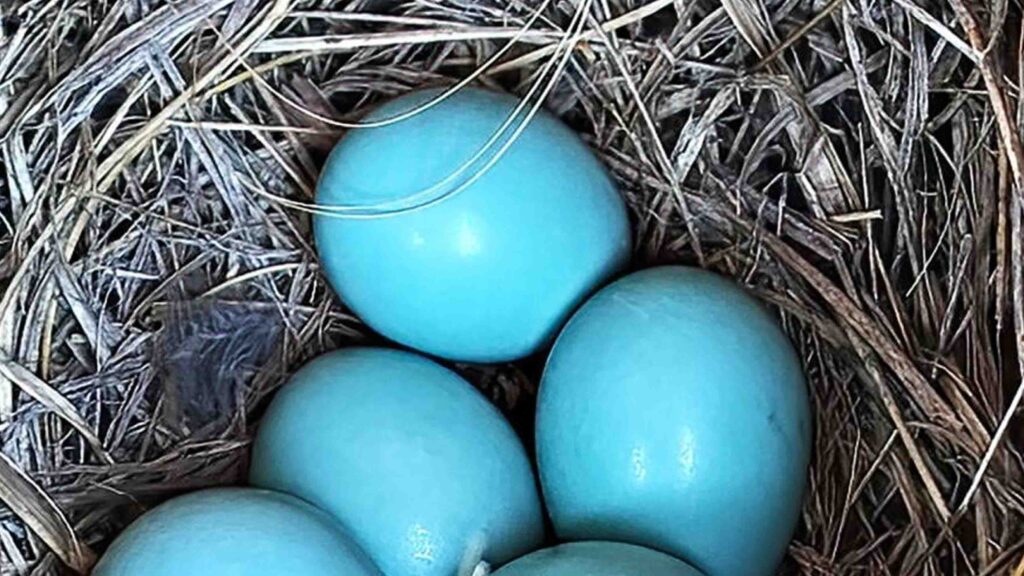Top Fascinating Birds That Lay Blue Eggs are a marvel of nature. Today, we are unveiling the mystery of blue bird eggs. Discover why some birds lay these stunning eggs and the secrets behind their unique color.
What Makes Blue Eggs So Unique?
Before we plunge into the specifics of birds that lay blue eggs, let’s take a moment to appreciate the uniqueness of these azure treasures. Blue eggs are a rare gem in the avian world, intriguing scientists and bird enthusiasts alike. With hues ranging from delicate pale blues to vibrant turquoise, they stand out amidst a sea of more conventional colors. But what exactly makes these eggs blue, and why do certain birds prefer this hue?
Surprising Birds That Lay Blue Eggs: A Complete Guide with Stunning Photos
Birds have been known to exhibit an astounding array of eggshell colors, and blue is undoubtedly one of the most mesmerizing. Let’s explore the spectrum of blue hues found in bird eggs and the species that lay them.

Pale Blue Wonders: Exploring the Soft Hues
- Light Blue Elegance: Some eggs exhibit a gentle light blue tint, almost reminiscent of a clear sky on a calm day.
- Turquoise Treasures: Turquoise eggs add a touch of the exotic to the avian palette.
- Royal and Deep Blues: In the spectrum of blue, these eggs flaunt deeper shades, captivating the observer with their richness.
A Kaleidoscope of Species: Birds and Their Blue Eggs
- The Blue Jay’s Hidden Gem: The iconic blue jay, a common sight in North America, boasts eggs with intricate blue patterns.
- The Thrush’s Delicate Creation: Thrush eggs exhibit a lovely light blue color that sets them apart.
- The Tiny Wonders of Chickadees: Chickadees contribute to the symphony of blue eggs with their small, sky-blue marvels.
- Bluebirds: True to Their Name: As if following a script, bluebirds lay eggs that resemble the clear blue sky.
- The Common Myna’s Unexpected Blue: The common myna’s otherwise unassuming appearance takes a colorful twist with its blue eggs.
The Science Behind the Blue: Why Blue Eggs?
The mystery of why some birds lay blue eggs has fascinated scientists for decades. While there isn’t a one-size-fits-all answer, there are several prevailing theories that shed light on this avian peculiarity.
Evolutionary Advantage or Visual Trickery?
- Camouflage and Protection: Some experts propose that blue eggs provide camouflage, blending in with the sky when viewed from below, thus safeguarding the eggs from predators.
- Temperature Regulation: Blue pigments in eggshells might help regulate temperatures within the egg, providing an ideal environment for embryonic development.
- Signaling Mate Quality: It’s possible that blue eggshell coloration could signal mate quality to potential partners, indicating the female’s ability to acquire essential nutrients for egg production.
Birds That Lay Blue Eggs: Everything You Need to Know with Pictures
The diversity of bird nests is truly astounding, ranging from simple scrapes on the ground to intricate woven structures in trees. Where do these birds that lay blue eggs choose to incubate their precious treasures?
From Ground to Treetop: Nesting Preferences
- Ground Nests: Some blue-egg-laying species, like the common myna, opt for ground nests concealed in shrubbery, providing a safe haven for their eggs.
- Cavity Nesters: Birds like the blue jay and bluebird prefer nesting in tree cavities, safeguarding their eggs within the confines of nature’s nooks.
- Open Cup Nests: Species like the chickadee create open cup nests, offering a panoramic view of their blue eggs, perched delicately amidst the branches.
Unveiling the Egg-laying Process: From Conception to Hatchling
The journey of a blue egg from its inception to hatching is a marvel of nature’s precision. Let’s take a closer look at the egg-laying process and the care these avian parents provide.
The Life Cycle of Blue Eggs
- Egg Formation: The process begins with the female’s reproductive system producing the egg yolk, which is then enveloped by egg white and the protective shell membrane.
- Pigment Deposition: The shell gains its color as pigment is deposited during its formation, resulting in beautiful hues that captivate our eyes.
- Incubation: Once laid, the eggs are incubated by the parent birds, providing the ideal temperature and environment for the embryos to develop.
- Hatching: After a period of incubation, the eggs crack open to reveal the vulnerable yet resilient hatchlings, ready to embark on their journey.
The Symbolism of Blue Eggs: Cultural and Natural Significance
Blue eggs hold a special place in human culture and history, with their own symbolism and significance that transcends the avian world.

Blue Eggs in Culture and Art
- Myths and Legends: Throughout history, blue eggs have been woven into myths and legends, often representing fertility, renewal, and the mysteries of life.
- Artistic Expressions: Artists have long been captivated by the delicate beauty of blue eggs, using them as motifs to convey themes of hope, fragility, and wonder.
A Natural Marvel in Our Midst
- Nature’s Palette: Blue eggs are a testament to the exquisite beauty and diversity of the natural world, inspiring awe and admiration in anyone who encounters them.
- Conservation Awareness: The presence of blue eggs in certain habitats can also serve as an indicator of the health of ecosystems, highlighting the importance of conservation efforts.
Final Thoughts on Blue Eggs:
In the ever-evolving tapestry of nature, blue bird eggs stand out as a remarkable masterpiece. From the spectrum of shades to the scientific marvel of their coloration, these eggs offer a glimpse into the intricacies of avian life. Whether for protection, communication, or simple aesthetic allure, the phenomenon of blue eggs continues to captivate our imagination, reminding us of the beauty that lies in the smallest of natural details.
FAQs
1. Why do some birds lay blue eggs?
Birds lay blue eggs for various reasons, including camouflage, temperature regulation, and mate signaling. The blue coloration serves different purposes for different species.
2. Are all blue eggs the same shade?
No, blue eggs come in a range of shades, from delicate pale blues to deep turquoise. Each species may have its unique variation of blue eggshell color.
3. Which birds are known for laying blue eggs?
Species like the blue jay, bluebird, common myna, and chickadee are known for laying blue eggs. Each species has its distinct nesting habits and shades of blue.
